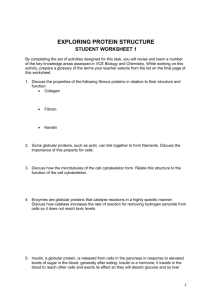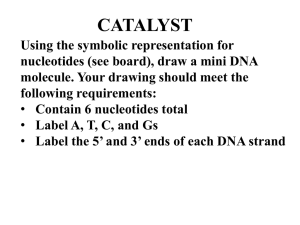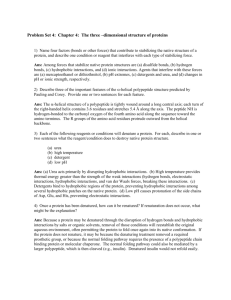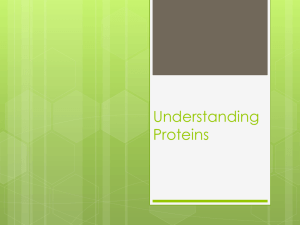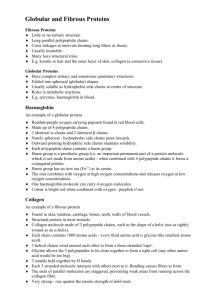Tertiary structure
advertisement
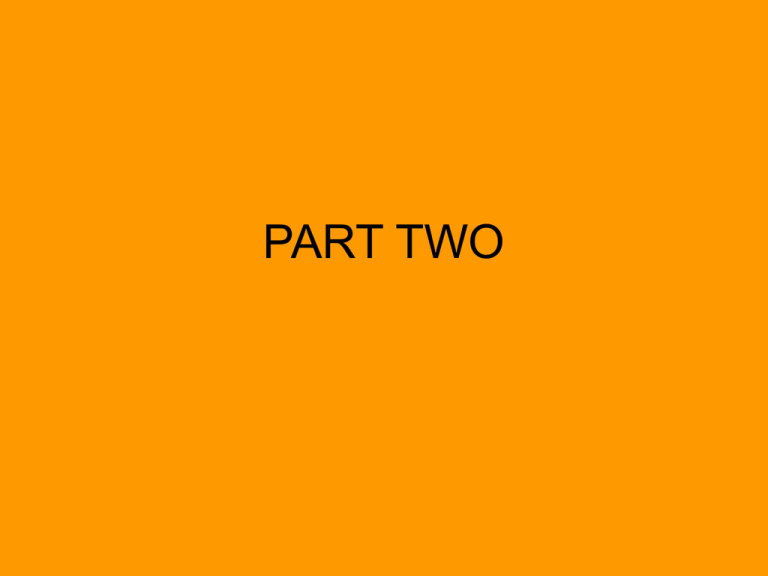
PART TWO • Long biochemically important proteins have certain folding patterns involving combinations of the different types of secondary structure patterns called super secondary structures. i.e these super secondary structures involve -helices and -sheets • The most common super secondary structure pattern is the sheet-turn-sheet pattern, of which large b-sheet array within a protein can be formed. • • • • • • • Among the frequently found folding patterns are the helix-turn-helix pattern the helix turn sheet pattern helix-turn-helix β & β unit, the leucine zipper the zinc finger Other types of helices or loops and turns can occur that differ from one protein to another (random coils). -TURN It’s the secondary level of protein organization which permit the change of direction of the peptide chain to get a folded structure They are known as well as reverse turns, hairpin bends or W loops SECONDARY-STRUCTURE FORMING AMINO ACIDS -helix -pleated sheet -turn Glutamate Tyrosine Aspartate Methionine Valine Serine Alanine Isoleucine Glycine Proline produces distortion of the structure Supersecondary structures Tertiary structure • The tertiary structure of a protein refers to its overall three-dimensional conformation. • Tertiary structure is the overall arrangement of secondary structure elements- the specific overall shape of a protein. • The "tertiary structure" of a protein refers to the protein's overall topology in space. • When you look at an actual polypeptide chain, the final shape is made up of secondary features, and some apparently random conformations. This overall structure is referred to as the tertiary structure. • This tertiary structure that finally determines the function of the protein, results from further folding of the protein leading to a unique three dimensional structure. • Tertiary structure is determined and stabilized by noncovalent interactions or chemical bonds and forces, including weak bonds (Hydrogen bonds, Ionic bonds, Van der Waals bonds, and Hydrophobic attractions). • The tertiary structure of a protein involves attractions and repulsions between the side chain groups of the amino acids in the polypeptide chain. • As interactions occur between different parts of the peptide chain, segments of the chain twist and bend until the protein acquires a specific threedimensional shape. Such interactions are produced between amino acid residues that may be located at a considerable distance from each other in the primary sequence of the polypeptide chain. • Note that hydrophobic interactions and non-polar side chains tend toward the center of the protein, while polar and charged side-chains tend toward the outside where they can interact with water. • To repeat: Hydrophobic amino acid residues tend to collect in the interior of globular proteins, where they exclude water, while hydrophilic residues are usually found on the surface, where they interact with water. • The types of interactions between amino acid residues that produce the three-dimensional shape of a protein include hydrophobic interactions, electrostatic interactions, and hydrogen bonds, all of which are noncovalent. Covalent disulfide bonds also occur. • REMEMBER! • Tertiary Structure of Globular Proteins is the folding of domains and final arrangement of domains in protein such that compact, hydrophobic side chains are buried in interior of the molecule, with maximum hydrogen bonding of hydrophilic groups within the molecule. Tertiary Structure • Specific overall shape of a protein • Cross links between R groups of amino acids in chain disulfide –S–S– + ionic –COO– H3N– H bonds C=O HO– hydrophobic –CH3 H3C– • • • • • • • • Cross-Links in Tertiary Structures The tertiary structure of a protein is stabilized by interactions between the R groups of the amino acids in one region of the polypeptide chain with R groups of amino acids in other regions of the protein. 1. Hydrophobic interactions are interactions between two nonpolar R groups. For example, hydrophobic interactions would occur between the aromatic group in phenylalanine and the alky group of valine or leucine. Within the compact shape of a globular protein, the amino acids with nonpolar side chains push as far away from the aqueous environment as possible, which forms a hydrophobic center at the interior of the protein molecule. 2. Hydrophilic interactions are attractions between the external aqueous environment and amino acids that have polar or ionized side chains. The polar side chains pull toward the outer surface of globular proteins to hydrogen bond with water. The presence of the hydrophilic side chains on the exterior surface makes globular proteins soluble in water. 3. Salt bridges are ionic bonds between side groups of basic and acidic amino acids, which have positive and negative charges. For example, at a pH of 7.4, the side chain of lysine has a positive charge, and the side chain of glutamic acid has a negative charge. The attraction of the oppositely charged side chains forms a strong bond called a salt bridge. If the pH changes, the basic and acidic side chains lose their ionic charges and cannot form salt bridges, which causes a change in the shape of the protein. 4. Hydrogen bonds form between polar amino acids. For example, a hydrogen bond can occur between the — OH of serine and the — NH of glutamine. 5. Disulfide bonds (— S — S —) are covalent bonds that form between the — SH groups of cysteines in the polypeptide chain. In some proteins, there are several disulfide bonds between the R groups of cysteine in the polypep tide chain. Interactions between amino acid R groups fold a protein into a specific three-dimensional shape called its tertiary structure. Myoglobin is a globular protein with a heme pocket in its tertiary structure that binds oxygen to be carried to the tissues. Globular and Fibrous Proteins Globular proteins “spherical” shape Insulin Hemoglobin Enzymes Antibodies Fibrous proteins long, thin fibers Hair Wool Skin Nails Globular and Fibrous Proteins • A group of proteins known as globular proteins have compact, spherical shapes because their secondary structures of the polypeptide chain fold over on top of each other. It is the globular proteins that carry out the work of the cells: functions such as synthesis, transport, and metabolism. • Myoglobin is a globular protein that stores oxygen in skeletal muscle. High concentrations of myoglobin have been found in the muscles of sea mammals, such as seals and whales, that stay under the water for long periods. Myoglobin contains 153 amino acids in a single polypeptide chain with about threefourths of the chain in the a-helix secondary I structure. • The polypeptide chain, including its helical regions, forms a compact tertiary structure by folding upon itself. Within the tertiary structure, a pocket of amino acids and a heme group binds and stores oxygen (02). • The fibrous proteins are proteins that consist of long, thin, fiber-like shapes. They are typically involved in the structure of cells and tissues. Two types of fibrous protein are the a- and β-keratins. • The a-keratins are the proteins that make up hair, wool, skin, and nails. In hair, three a-helixes coil together like a braid to form a fibril. Within the fibril, the a-helices are held together by disulfide (— S S —) linkages between the R groups of the many cysteine amino acids in hair. Several fibrils bind together to form a strand of hair. • The β-keratins are the type of proteins found in the feathers of birds and scales of reptiles. In β-keratins, the proteins consist of large amounts of β-pleated sheet structure. The tertiary structure of a protein refers to its overall three-dimensional conformation. • It is produced by interactions between amino acid residues that may be located at a considerable distance from each other in the primary sequence of the polypeptide chain. • Hydrophobic amino acid residues ten to collect in the interior of globular proteins, where they exclude water, while hydrophilic residues are usually found on the surface, where they interact with water. • The types of interactions between amino acid residues that produce the three-dimensional shape of a protein include hydrophobic interactions, electrostatic interactions, and hydrogen bonds, all of which are noncovalent. Covalent disulfide bonds also occur. Tertiary Structure of Globular Proteins Tertiary structure – folding of domains and final arrangement of domains in protein Compact, hydrophobic side chains buried in interior Maximum hydrogen bonding of hydrophilic groups within molecule Figure 2.10, tertiary structure of Trypsin Learning Check P2 Select the type of tertiary interaction as (1) disulfide (2) ionic (3) H bonds (4) hydrophobic A. B. C. D. Leucine and valine Two cysteines Aspartic acid and lysine Serine and threonine Solution P2 Select the type of tertiary interaction as (1) disulfide (2) ionic (3) H bonds (4) hydrophobic A. B. C. D. 4 1 2 3 Leucine and valine Two cysteines Aspartic acid and lysine Serine and threonine Quaternary Structure • The quaternary structure of a protein refers to the spatial arrangement of subunits in a protein that consists of more than one polypeptide chain. • Only proteins with two or more chains have quaternary structures. A good example is hemoglobin, the globular protein molecule that carries oxygen in blood. • The quaternary structure of hemoglobin consists of four polypeptide chains or subunits, two alpha chains and two beta chains. Each chain contains a heme group that binds an oxygen molecule. • The subunits are held together in the quaternary structure by the same types of noncovalent interactions that join various segments of a single chain to form and stabilize the tertiary structure, such as hydrogen bonds and salt bridges between side groups, disulfide links, and hydrophobic attractions. • Quaternary structure • Many biological proteins are constructed of multiple polypeptide chains. Often a single "protein" consists of more than one polypeptide chain. Each polypeptide chain is called a "subunit." The way these chains fit together or associate with one another is referred to as the "quaternary structure." • The quarternary structure of the protein refers to the way multiple subunits of a protein interact. This is the arrangement of the individual subunits of a protein with multiple polypeptide subunits (i.e. hemoglobin has 2 alpha and 2 beta subunits). Only proteins with multiple polypeptide subunits have quaternary structure. The local arrangement of the different chains to each other is very crucial for the function of the protein. • Note the following about the subunits that constitute a protein. • a. "dimers" consist of two subunits ; a protein can be a "homodimer" (the two subunits are identical, and often arranged symmetrically), or a "heterodimer" (subunits are different). • b. multimers, consist of many subunits • REMEMBER: The quarternary structure of the protein refers to the way multiple subunits of a protein interact. This is the arrangement of the individual subunits of a protein with multiple polypeptide subunits (i.e. hemoglobin has 2 alpha and 2 beta subunits). Only proteins with multiple polypeptide subunits have quaternary structure. The quaternary structure of hemoglobin consists of four polypeptide subunits, each containing a heme group that binds an oxygen molecule. • The primary structure of a protein consists of the amino acid sequence along the chain. • Secondary structure involves -helices, sheets, and other types of folding patterns. • Tertiary structure (the three-dimensional conformation of a protein) involves electrostatic and hydrophobic interactions and hydrogen and disulfide bonds. • Quaternary structure refers to the interaction of one or more subunits to form a protein. Hierarchy of structures in proteins LEVELS OF ORGANIZATION OF PROTEIN STRUCTURE Quaternary level Tertiary level Primary level Secondary level Interactions between amino acid residues in a polypeptide chain. • Let us now briefly discuss the bonding found in the primary, secondary, tertiary and quaternary structures of proteins in more detail. There are several important, non-covalent, interactions between amino acid side chains: • Electrostatic interactions • van der Waals interactions • Hydrogen bonds • Hydrophobic interactions • Very stable interactions known as salt bridges can occur when two oppositely charged side chains are in close proximity. A protein chain will also have one free alpha-amino group and one free alpha-carboxyl group which can participate in electrostatic interactions. • van der Waals interactions result from the presence of transient changes in the electron distribution around an atom. These changes result in complementary changes in the electron distribution around an adjacent atom. The net result of this process is the formation of an attractive force. This force only occurs if atoms are in close proximity, and the magnitude of the force decreases with sixth power of the separation distance. At very close contact, however, repulsion between electron clouds counteracts the attractive force. The distance at which this occurs is known as the van der Waals radius. • Hydrogen bonds are not intrinsically very strong, but as there are so many hydrogen bond donors and acceptors in proteins they are very significant overall, and very important in both the structure and interactions in proteins. • In a protein molecule hydrogen bonds form concerted hydrogen bond networks involving many side chains. • This is facilitated by the fact that some atoms such as oxygen can act as both hydrogen bond donors and acceptors: • Hydrogen bonds result from the partial sharing of a hydrogen atom between two electronegative atoms. The hydrogen atom that is shared has it's electron delocalised onto the atom to which it is covalently bonded, resulting in it posessing a partial positive charge. • This charge separation allows an electrostatic interaction between the hydrogen and another, electronegative, atom. In proteins the important electronegative atoms are oxygen and nitrogen as both donors and acceptors. • These atoms are found on the polypeptide backbone and on side chains of amino acids such as the acidic and basic amino acids e.g. the hydroxyl amino acids serine and threonine. • (NB THE STATEMENT the hydroxyl amino acids serine and threonine GO BACK AND CHECK THE STRUCTURES AND SEE WHY THIS SHOULD BE SO. • • • • • • • • • Hydrophobic interactions occur between non-polar molecules in the presence of a polar solvent such as water. In the context of protein structures, several amino acid side chains are, to varying degreees, hydrophobic. The most hydrophobic of the amino acid side chains are those of alanine, valine, leucine and isoleucine.(VAIL) These amino acids side chains are bulky alkyl chains with different molecular geometries. It is a general rule (with, of course, many exceptions) that these residues are found in the interior of protein molecules where they form a hydrophobic core containing very little water. It is believed that the different molecular geometries of the side chains are important in facilitating close packing of the alkyl chains inside the protein. Another group of hydrophobic resdiues are the aromatic amino acids tyrosine tryptophan and phenylalanine. These amino acids are the residues responsible for the uv absorbance of proteins and also participate in hydrophobic interactions. There is one more amino acid that can participate in hydrophobic interactions, although it is more polar than the others. This is one of the sulphur-containing amino acids, methionine. NOTE THIS STATEMENT METHIONINE CAN PARTICIPATE IN HYDROPHOBIC REACTIONS ALTHOUGH IT IS POLAR. Can you see why from the structure? So far, we have only discussed non-covalent interactions between side chains. There is, however, one very important covalent interaction that represents a stabilising influence in protein molecules, the disulphide bond. The side chain of the amino acid cysteine contains a highly reactive thiol group. Two such thiol groups can react to form a disulphide bond. These bonds are always formed after protein biosynthesis and contribute to the stability of the folded state by linking together distant parts of the polypeptide chain. •END
